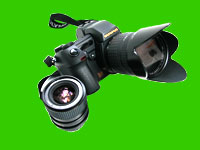 A
Page for Useful Information:
A
Page for Useful Information:
More on Raw Capture
Arguments have been raging among the professionals - and indeed, some have become quite personal and insulting - as to whether 16bit {raw},has any advantage over 8bit. As far as the end product is concerned, the safest gambit is to try it and see for yourself if you prefer it. The one big question that I had to search long and hard for to find an answer is what happens to a 16bit file when you send it to an 8bit printer, which is all we have at the moment. Everybody declined to answer that one until I cornered a guy who writes the drivers for Epson printers. This fellow clearly lives in a parallel universe and ate, slept and drunk code. However, finally pinning him down to words of one syllable, he said that the driver interpolated the 16bit information down to 8 bit and although some of the info was lost, not all of it was, so there is a certain advantage in printing 16bit.
Actually being able to see the difference is another matter, so it's another case of 'suck it and see'. What is clearly an advantage though is in the editing of 16 bit files. When you have twice the amount of pixel information, you have a distinct 'overhead' when applying curves etc and the picture is not so likely to break up so easily. It will withstand more of an onslaught in other words, but of course, we all get our pictures just right anyway don't we? With Photoshop CS2 you can tick the right boxes that will send your 16bit file {once you've finished editing it in the raw capture dialogue}, into PS as an 8bit file and you can carry on from there, or edit in 16bit and convert to 8 bit before printing, the choice is yours. One thing is sure though, once you've seen raw capture in operation, you won't want to go back to jpeg, it starts to look so, what shall we say, unsubtle? Of course, all this involves a change of workflow but you soon get used to it and there are all sorts of widgets in Bridge to help you along.
Here's a little wrinkle ....
If you've got a sky that is too weak or you want to emphasise the cloud patterns, try the following:
1. In RGB make a duplicate layer by dragging your background layer to the 'new layer' icon at the bottom of the layers pallette.
2. Go to Image, Apply Image, select 'background layer' in the layer box, select Red in the channel box, mode Darken, opacity 100% and click OK
3. Now change the layer mode to Luminosity. {The background copy layer}
4. Now adjust the layer opacity to taste.
If undesired areas are affected by any of these moves, just get a brush, make sure the background copy layer is highlighted, and click on the layer mask icon at the bottom of the layers pallette. Now click on the square icon on the layer to make sure you're working on the mask and paint away with a large black soft brush where you don't want the effect to be. To paint it back again, just paint with white.